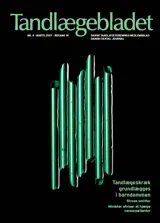Knogleerstatningsmaterialer – hvor langt er vi nået?
Autolog knogle betragtes fortsat som guldstandarden ved ossøs rekonstruktion. Da anvendelse af autolog knogle imidlertid er behæftet med en række ulemper, er der de seneste 30-40 år foregået en intens søgen efter det ideelle alternativ. I nærværende oversigt redegøres der kort for hvor vi er nået til i dag, samt hvilke udfordringer vi fortsat står over for både på kort og på længere sigt.
Bone substitutes – how far have we come? For many years, autogenous bone from intra- and extra-oral donor sites has been considered the gold standard in osseous reconstructive surgery. Searching for the ideal bone grafting material, one has to be aware of the variety of indications for bone reconstruction. These range from the augmentation of small peri-implant defects, extraction sockets, or cyst cavities with optimal osseous healing conditions to the situations where a severe trauma or tumour resection requires reconstruction of major parts of the facial skeleton, situations where the biological healing potential is pushed to the outer limit. With this in mind, it is not surprising that the single ideal bone grafting material does not exist. Not even the gold standard – autogenous bone – can be considered ideal in every situation due to donor site morbidity, risk of resorption and limited availa ble quantities. With the main goal of reducing or even eliminating the shortcomings of autografts, the search for a suitable bone substitute material has been going on for the past 30-40 years. The present review presents the current status on bone substitutes, and points out the short-term and long- term challenges that we are facing.


